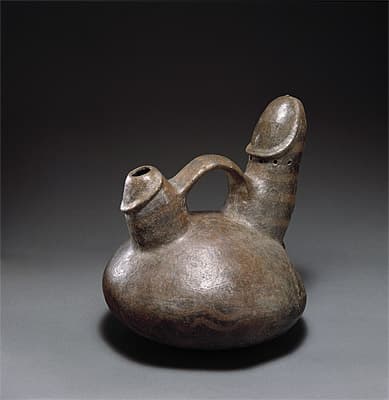VICÚS culture North coast 100 BC – 400 AD
Bridge vessel with two penises 100 BC - 400 AD ceramic24.0 (h) x 19.8 (w) x 20.6 (d) cm Museo Larco, Lima Photograph: Museo Larco
Vicús pottery is easily recognised by its rather crude construction. The simply polished vessels are thick and often unsymmetrical in shape. The Vicús also used poor quality clay that, combined with low firing temperatures, resulted in fragile pots with surfaces that were easily chipped and cracked. In this, they markedly lack the appearance and finesse of Moche pottery, which developed concurrently during its formative period. And, unlike their counterparts, the Vicús produced only a small amount of pottery, which was formed by hand rather than using a mould.1 Not surprisingly, considering their rough construction and fragility, this pottery only appears in their own tombs and grave sites. In addition, however, Vicús tombs have been found to contain large quantities of Moche ceramics. This suggests not only the pervasive value of the finer Moche pottery, but that trade existed between the two cultures.
This particular Vicús work demonstrates strong connections with and the influence of the famous erotic pots of the Moche (cats 102–106). Here, a stirrup handle appears across the top of the bold penis-shaped spouts of this vessel. While the Vicús largely made double-chambered bottles and single-spout bridge bottles, they only occasionally copied the Moche stirrup-spout pots. In most cases, Vicús pottery was decorated with geometric and line patterning, using the resist technique (see cat. 10). Subtle wavy lines can be seen around the outside of the circular body of this pot, as well as on the shafts of the penises.
Simeran Maxwell
1. Christopher B. Donnan, Ceramics of ancient Peru, Los Angeles: Fowler Museum of Cultural History, UCLA 1992, pp. 70–74.
Vicús pottery is easily recognised by its rather crude construction. The simply polished vessels are thick and often unsymmetrical in shape. The Vicús also used poor quality clay that, combined with low firing temperatures, resulted in fragile pots with surfaces that were easily chipped and cracked. In this, they markedly lack the appearance and finesse of Moche pottery, which developed concurrently during its formative period. And, unlike their counterparts, the Vicús produced only a small amount of pottery, which was formed by hand rather than using a mould.1 Not surprisingly, considering their rough construction and fragility, this pottery only appears in their own tombs and grave sites. In addition, however, Vicús tombs have been found to contain large quantities of Moche ceramics. This suggests not only the pervasive value of the finer Moche pottery, but that trade existed between the two cultures.
This particular Vicús work demonstrates strong connections with and the influence of the famous erotic pots of the Moche (cats 102–106). Here, a stirrup handle appears across the top of the bold penis-shaped spouts of this vessel. While the Vicús largely made double-chambered bottles and single-spout bridge bottles, they only occasionally copied the Moche stirrup-spout pots. In most cases, Vicús pottery was decorated with geometric and line patterning, using the resist technique (see cat. 10). Subtle wavy lines can be seen around the outside of the circular body of this pot, as well as on the shafts of the penises.
Simeran Maxwell
1. Christopher B. Donnan, Ceramics of ancient Peru, Los Angeles: Fowler Museum of Cultural History, UCLA 1992, pp. 70–74.
Vicús pottery is easily recognised by its rather crude construction. The simply polished vessels are thick and often unsymmetrical in shape. The Vicús also used poor quality clay that, combined with low firing temperatures, resulted in fragile pots with surfaces that were easily chipped and cracked. In this, they markedly lack the appearance and finesse of Moche pottery, which developed concurrently during its formative period. And, unlike their counterparts, the Vicús produced only a small amount of pottery, which was formed by hand rather than using a mould.1 Not surprisingly, considering their rough construction and fragility, this pottery only appears in their own tombs and grave sites. In addition, however, Vicús tombs have been found to contain large quantities of Moche ceramics. This suggests not only the pervasive value of the finer Moche pottery, but that trade existed between the two cultures.
This particular Vicús work demonstrates strong connections with and the influence of the famous erotic pots of the Moche (cats 102–106). Here, a stirrup handle appears across the top of the bold penis-shaped spouts of this vessel. While the Vicús largely made double-chambered bottles and single-spout bridge bottles, they only occasionally copied the Moche stirrup-spout pots. In most cases, Vicús pottery was decorated with geometric and line patterning, using the resist technique (see cat. 10). Subtle wavy lines can be seen around the outside of the circular body of this pot, as well as on the shafts of the penises.
Simeran Maxwell
1. Christopher B. Donnan, Ceramics of ancient Peru, Los Angeles: Fowler Museum of Cultural History, UCLA 1992, pp. 70–74.


